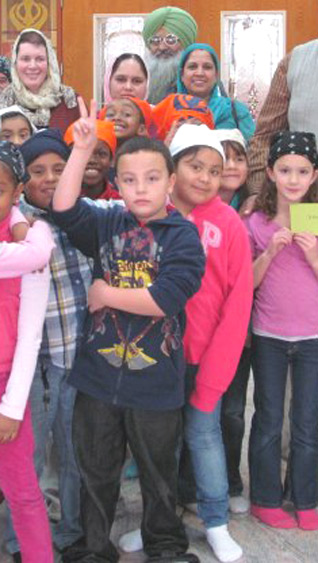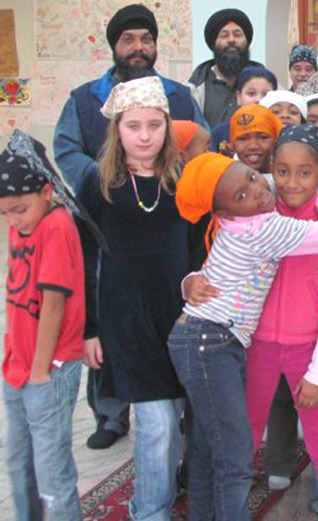Current Events
Healing in a Milwaukee Classroom
MOLLY SNYDER
Milwaukee, Wisconsin, USA
Sadly, one of the Milwaukee area's most horrendous tragedies occurred this year when a white supremacist shot and killed six people August 5 at the Gurdwara in Oak Creek. He then shot himself dead.
The incident inspired reactions from individuals worldwide, including President Barack Obama and Indian Prime Minister Manmohan Singh. Michelle Obama made a visit to the gurdwara on August 23.
People mourned all over the world and dignitaries attended candlelight vigils in the United States, Canada and around the world. Many local communities were in shock, but people found ways to reach out to the Sikh-American community.
It has now been more than four months since the tragedy and it's time to check in to see if there are any signs of healing.
Amardeep Singh Kaleka lost his father, Satwant Singh Kaleka – one of the founders of this gurdwara – in the shooting. Amardeep says there has been a lot of grieving, but also the start of some healing over the past months.
"A lot of our healing has come from the community and because of connections we've made with inter-faith councils. The support we've received from the city of Oak Creek and the NAACP has been exceptional," he says.
Amardeep, who was visiting Milwaukee for a family reunion the weekend his father was killed, lives in Los Angeles with his wife and 18-month-old son where he works as a filmmaker. He and his family were on their way to the gurdwara when he received a call from his mother reporting what had happened.
After an almost week-long investigation, the members of the congregation were allowed access to the gurdwara again, and Amardeep spent the weekend preparing for a Sunday service. He cleaned blood stains in the empty gurdwara all day and all Saturday night.
"People told me, 'your family doesn't have to do this,' but we did. It was my father's life, his life savings," says Amardeep.
Dale Weiss, a Milwaukee Public School teacher, was one of 2,300 people who attended the service that day. Weiss says she felt a compulsion to attend the service, but also recognized a trace of fear.
"What if something bad would again happen this Sunday? Was it safe to go there? I could barely imagine the fear that many Sikhs may have felt entering their gurdwara a mere week after such a horrific event took place and knew my own paled in comparison," she says.
Weiss arrived at the gurdwara at 8 a.m. and stayed until the middle of the afternoon.
"There was sadness. There was grief. There was peace. People came and went, prayed, chatted, hugged and cried. I prayed, observed and participated as best as I could, ever mindful of an undeniable feeling of graciousness and love that permeated every inch of the gurdwara," says Weiss.
Weiss, who teaches second grade at La Escuela Fratney, decided she was going to teach her kids about the Sikh community. She read everything she could about the religion prior to the first day of school. On the second day, she began.
"I remember thinking I must be somewhat 'crazy' for wanting to start a unit on the Sikhs the second day of school. There were so many routines and procedures to teach, so many supplies and books to hand out and so much other curriculum to begin," says Weiss. "As the list of things I had to do grew longer and longer, I remembered the faces of the many people in the Sikh community. I knew this was what I must do."
Weiss started by teaching the kids about peace and had them envision what a peaceful classroom looks like, as well as complete the sentence, "I am a peacemaker because I ..."
The next day, she asked the students if they had heard anything about the Sikh community and what had happened in their temple. Multiple students had heard stories on the news. They spoke about what happened, she assured them they were safe and they were very empathetic.
Weiss continued the course of study by reading to them children's books called "I Belong To the Sikh Faith" and "The Boy with the Long Hair." They later watched "The Sikh Next Door," a DVD about Sikh children.
Together, after much discussion, the kids decided what they all have in common is that they are all different. One child asked if they could write that on a banner. And so they did. Later, another student asked if they could make cards for members of the Sikh community. The card idea turned into a book and each student contributed three pages.
The following day, Sukhjinder Kaur and her college-age son Paramveer Singh visited the classroom.
The students were able to share what they'd already learned. They asked more questions; they learned how to put on a turban and patka. They listened to the tablas (drums), read a bilingual (English/Punjabi) book together with their guests and sang two songs about peace.
Then they presented the book they had made for their new friends in the Sikh community.
"It was a very moving experience," says Weiss.
On November 19, Weiss and her second graders took a field trip to the Gurdwara in Oak Creek. Two days later they celebrated Heritage Day, an initiative started by members of the Sikh community who formed an organization called Serve 2 Unite in an effort to end violence and hate through educating one another about our different heritages.
Amardeep, his wife, and 2-year-old son joined Weiss and the students in a potluck meal comprised of various foods from the heritages of the students.
"The children immediately bonded with Amardeep and when it was time to say goodbye, they encircled their arms around him in a huge hug. As I stood there, I knew our unit on the Sikhs had come full circle. We began by learning about a tragedy and ended by sharing love with someone whom that tragedy had affected so deeply," says Weiss.
Amardeep said it was a wonderful experience for himself and his family.
"Those kids are beautiful. They knew who I was when I walked in the door. They said my name properly," he says. "They told me where they were from. 'I'm from Honduras!' 'I'm from Puerto Rico!' These little kids have already figured it out at such a young age."
Weiss says she plans to teach her students about the Sikh community every year. Amardeep feels this kind of education about who the Sikhs are is absolutely necessary to prevent misinformation, hatred, and violence and in order to continue the healing process.
"We need to take responsibility and let people know about our culture," says Amardeep. "It will never be what it was, but over time, we will feel like we can move on."
[Courtesy: On Milwaukee. Edited for sikhchic.com]
December 10, 2012
Conversation about this article
1: Pritam Singh Grewal (Canada), December 10, 2012, 2:51 PM.
Understanding among different cultures and communities brings out the light of love and dispels the darkness of aloofness.
2: Jaspreet (Canada), December 11, 2012, 1:44 AM.
I bet the memories from this unit will stick for decades in the children.




